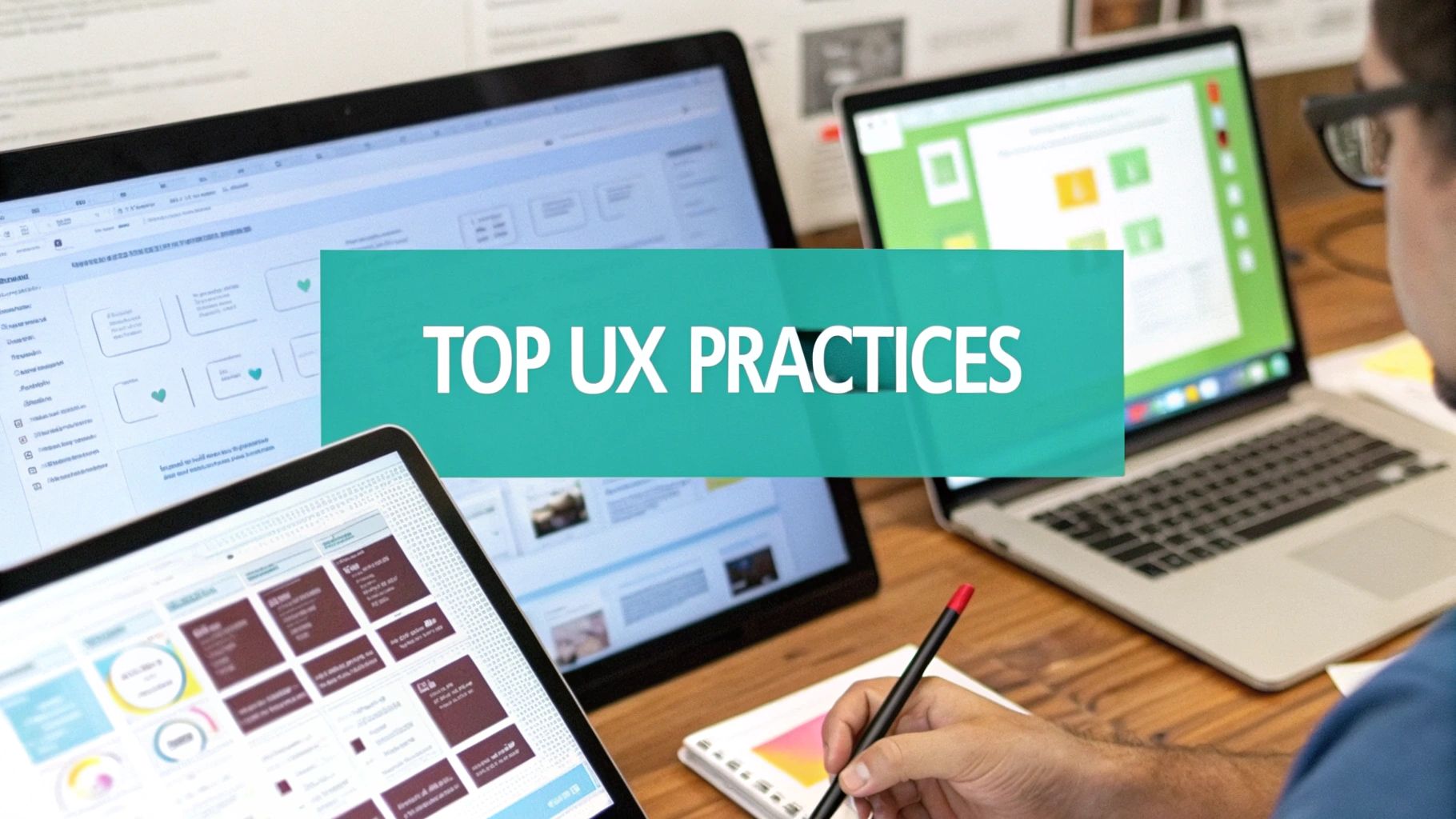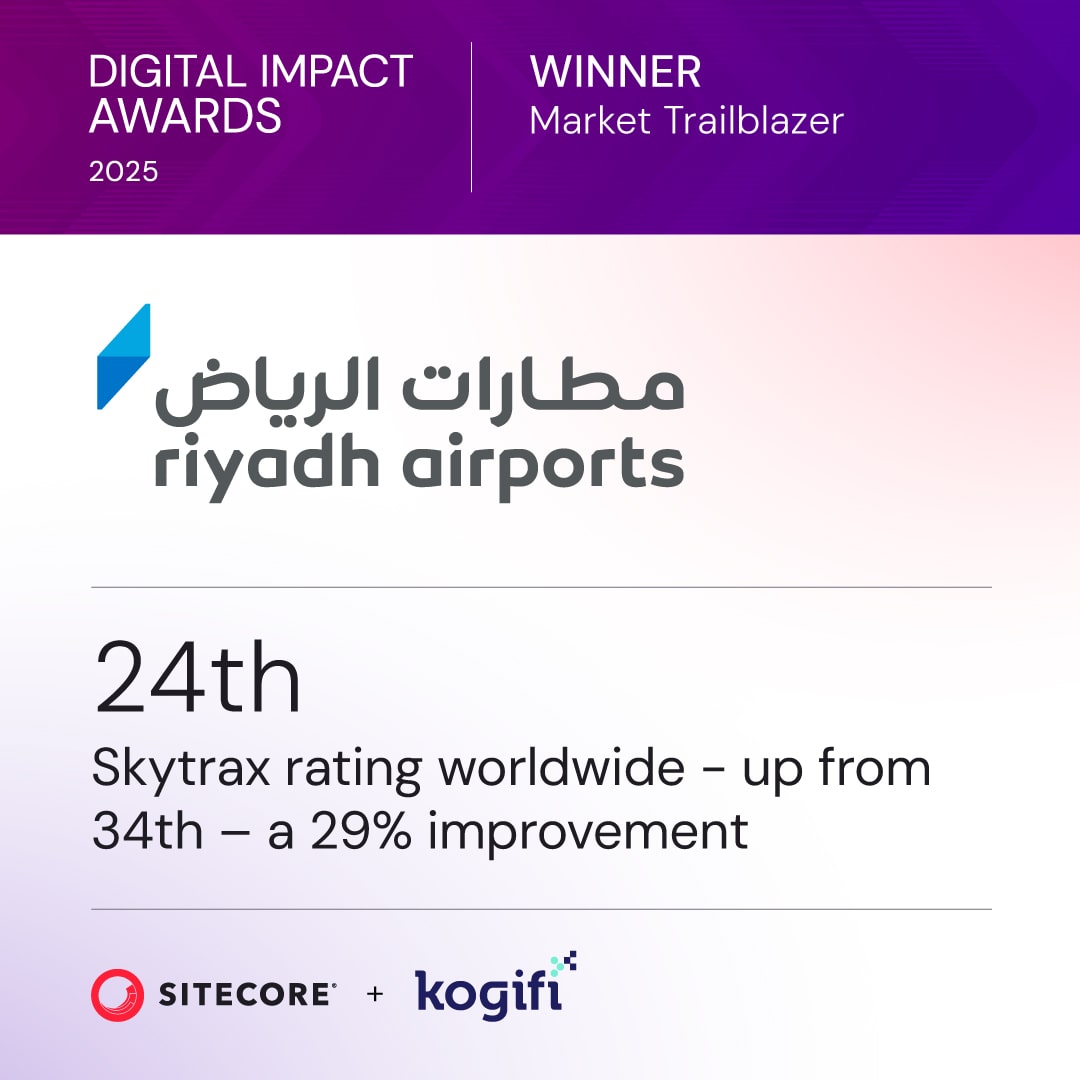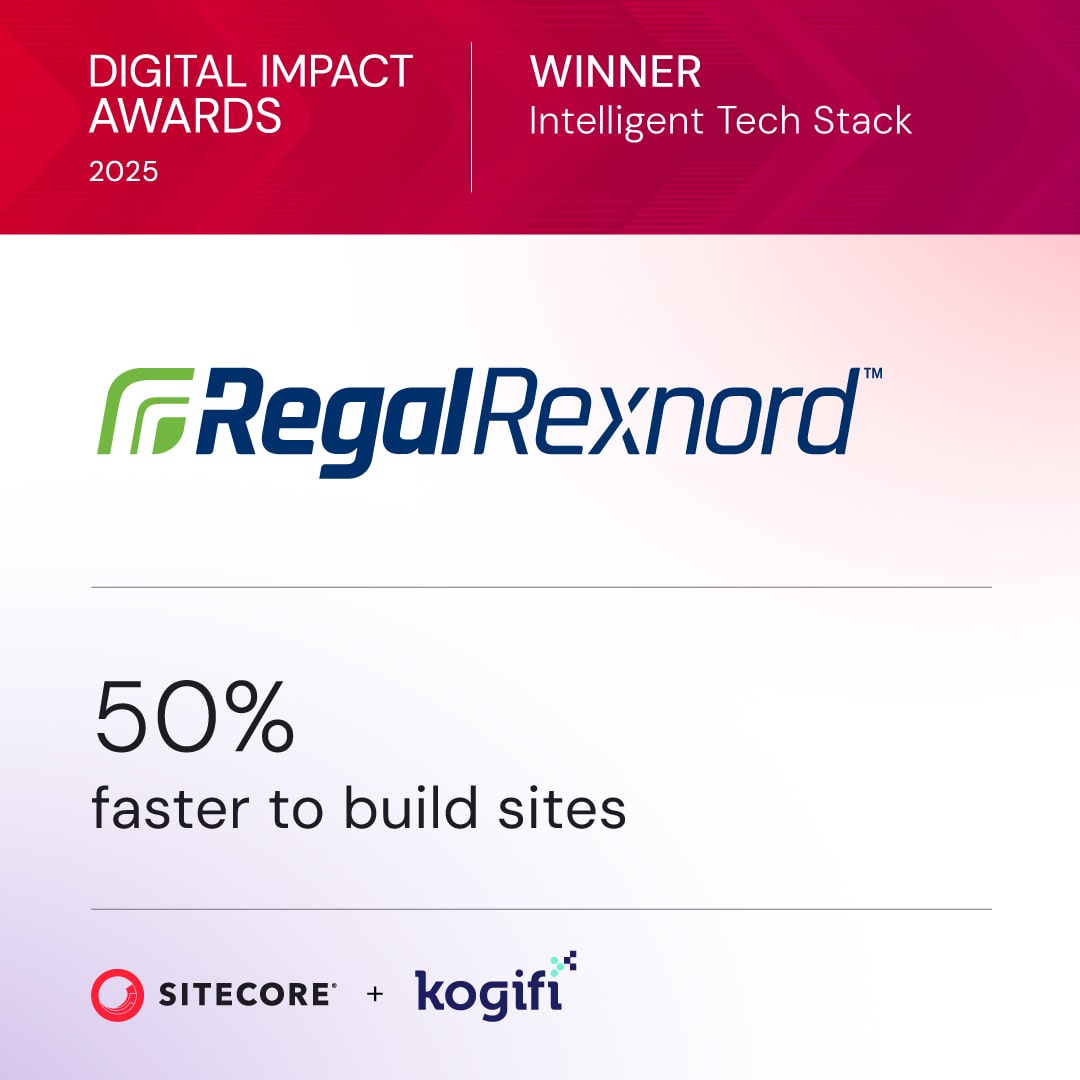Choosing the right Enterprise Content Management (ECM) system is a critical decision that impacts everything from operational efficiency and compliance to the customer journey. The market is saturated with powerful platforms, but the best enterprise content management systems are not one-size-fits-all. The ideal solution must align perfectly with your organization's unique digital ambitions, governance needs, and existing technical ecosystem.
This guide cuts through the marketing noise to provide an in-depth, practical analysis of the leading solutions available today. We begin with a deep dive into the Sitecore ecosystem, showcasing how its comprehensive Digital Experience Platform (DXP) capabilities transform static content into personalized, omnichannel customer experiences. Following our Sitecore analysis, we will explore the robust, collaboration-centric world of Microsoft SharePoint and its deep integration with the Microsoft 365 suite.
From there, we review other top-tier platforms, each evaluated for its specific strengths and ideal use cases. This resource is designed for enterprise leaders, digital marketers, and IT professionals seeking not just a system, but a strategic partner for digital growth. To truly find your perfect CMS fit, it's essential to first grasp the overarching advantages of moving away from traditional paper processes and embracing the powerful Benefits of Document Management Systems.
Our analysis focuses on real-world implementation insights, honest limitations, and the critical factors that drive long-term ROI. Each platform review includes screenshots and direct links, equipping you with the information needed to make a confident and informed decision for your enterprise.
1. Sitecore's Composable DXP Ecosystem
Sitecore has evolved far beyond a traditional content management system into a fully composable Digital Experience Platform (DXP). This modern, API-first architecture allows enterprises to assemble a best-of-breed technology stack, selecting individual components like Content Cloud, Engagement Cloud, and Commerce Cloud to create a tailored solution. This approach provides unparalleled flexibility, enabling organizations to integrate Sitecore’s powerful tools with their existing systems and adapt their digital capabilities as market demands change. For enterprises prioritizing customer experience, Sitecore’s portfolio—including XM Cloud, OrderCloud, CDP, and Personalize—offers an integrated suite to manage the entire customer lifecycle, making it a definitive leader among the best enterprise content management systems.
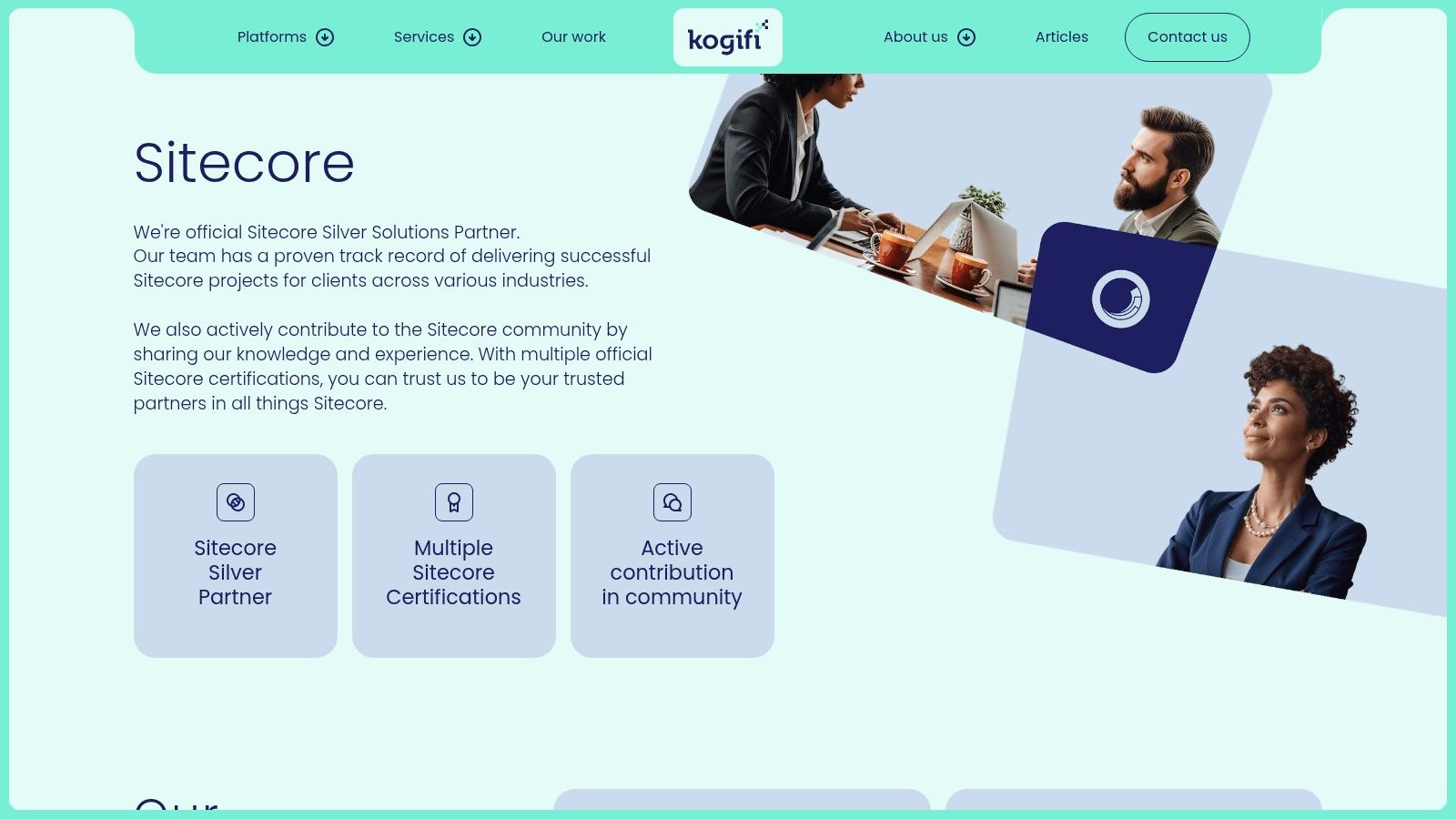
The true power of Sitecore lies in unifying content, data, and commerce to deliver hyper-personalized experiences at scale. With Sitecore CDP, businesses can build a unified customer profile from disparate data sources. This data then fuels Sitecore Personalize, an advanced decisioning engine that delivers real-time, one-to-one engagement across any channel. The transition to a cloud-native, SaaS model with products like XM Cloud further empowers enterprises with greater agility, scalability, and reduced infrastructure overhead. More information can be found on sitecore.com.
Key Strengths and Use Cases
The Sitecore DXP is engineered for global enterprises that view digital experience as a core competitive differentiator. It excels in complex multi-brand, multi-lingual, and multi-site scenarios where delivering consistent, personalized content is paramount. The platform’s headless capabilities allow for omnichannel content delivery to websites, mobile apps, IoT devices, and more, all from a single content repository. This makes it ideal for industries like manufacturing, financial services, and retail, where the customer journey spans multiple digital and physical touchpoints.
A key differentiator is the focus on data-driven marketing and commerce. By connecting content management with powerful analytics, personalization, and e-commerce engines (like Sitecore OrderCloud for B2B/B2C/B2X), businesses can move beyond simple content publishing to creating intelligent, revenue-generating digital ecosystems. For a deeper dive into how such platforms fit into a broader strategy, you can explore detailed analyses of enterprise content management solutions on kogifi.com.
Practical Considerations
- Best For: Global enterprises in sectors like finance, manufacturing, and healthcare that require a robust, scalable, and highly personalized digital presence managed by a dedicated expert team.
- Pricing: Sitecore involves significant licensing costs based on the specific products chosen (e.g., XM Cloud, CDP, Personalize). Implementation requires a specialized partner, and total investment should be evaluated against expected ROI from improved customer engagement and conversion.
- Not Ideal For: Small businesses or organizations with simple content needs, lacking the budget or strategic imperative for an enterprise-grade DXP.
Website: https://www.kogifi.com/platforms/sitecore
2. Microsoft SharePoint (Microsoft 365)
For enterprises deeply integrated into the Microsoft 365 ecosystem, SharePoint Online serves as the backbone for internal content management and collaboration. It is not just a document repository but a comprehensive platform for building intranets, team sites, and communication portals that drive organizational knowledge sharing. Its primary strength lies in its seamless, native integration with other Microsoft tools like Teams, OneDrive, Power BI, and the Power Platform. This unified digital workplace allows employees to co-author documents, manage project workflows, and access critical information without ever leaving their familiar work environment.

As one of the best enterprise content management systems for internal operations, SharePoint excels at scale. Its robust permissioning model, records management capabilities, and compliance features provide the governance needed for large, regulated organizations. The introduction of Microsoft Syntex enhances SharePoint with AI-powered content processing, enabling automated document classification, metadata extraction, and content assembly, transforming unstructured information into actionable knowledge.
Key Considerations
Pricing is a significant advantage, as SharePoint is bundled within most Microsoft 365 Business and Enterprise plans, offering a predictable per-user cost model. However, unlocking its full potential often requires additional investment. Advanced capabilities like Microsoft Syntex or premium connectors for the Power Platform come with add-on licensing fees. Furthermore, while SharePoint is powerful out-of-the-box, implementing sophisticated governance, information architecture, and custom workflows at an enterprise scale demands specialized expertise to prevent site sprawl and ensure long-term manageability. To understand more about its architecture, explore the fundamentals of cloud-based CMS solutions.
- Pros: Pervasive in corporate environments, straightforward per-user pricing, built for massive scale.
- Cons: Advanced features require premium add-on licenses, complex governance needs expert management.
- Website: https://www.microsoft.com/microsoft-365/sharepoint/compare-sharepoint-plans
3. OpenText Content Cloud (Content Suite / Documentum / Core Content)
OpenText stands as a heavyweight in the ECM space, offering a comprehensive portfolio designed for the most demanding, large-scale, and highly regulated environments. Its strength lies in its specialized product families, like Documentum and Content Suite, which provide end-to-end control over the entire content lifecycle, from capture and governance to final archiving. This platform is engineered for industries where stringent compliance and records management are non-negotiable, such as life sciences, energy, and the public sector. Its ability to integrate deeply with core enterprise systems like SAP, Microsoft, and Salesforce makes it a central pillar for information governance.
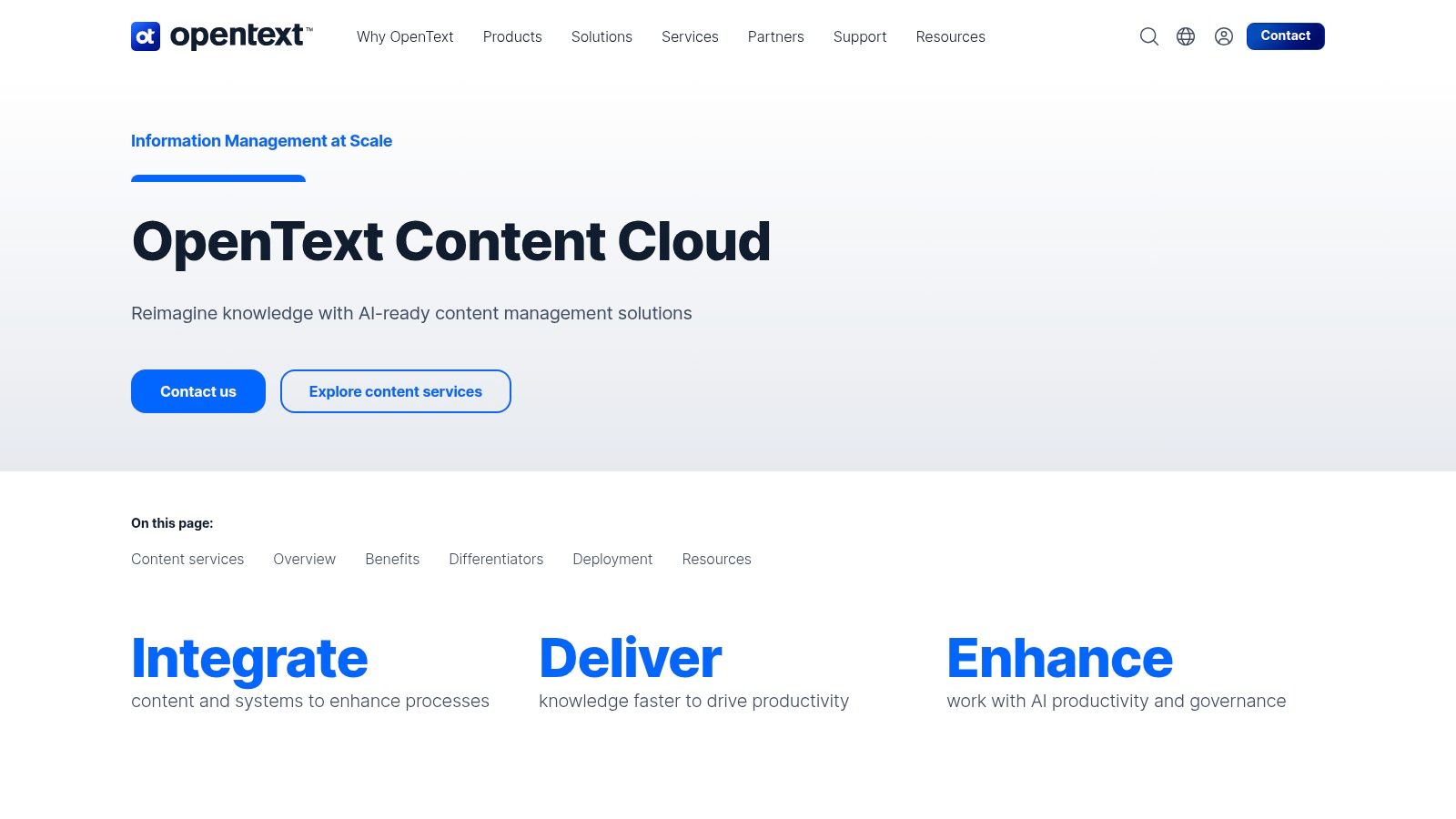
As one of the best enterprise content management systems for complex compliance needs, OpenText provides unparalleled deployment flexibility. Organizations can choose between SaaS (Core Content), private cloud, or traditional on-premise solutions to meet specific data sovereignty or security requirements. Its mature ecosystem of service partners ensures that enterprises have access to specialized expertise for implementation and ongoing management.
Key Considerations
Pricing for OpenText's solutions is enterprise-grade, typically requiring a custom quote based on the specific products, deployment model, and scale of the implementation. The platform's sheer power and breadth also mean it comes with inherent complexity; successful deployment and maintenance demand significant planning and specialized skills. Furthermore, migrating between its different product families can be a major project requiring detailed strategic planning. Explore the core benefits of enterprise content management to understand how such a system fits into a larger business strategy.
- Pros: Deep industry and regulatory fit, broad deployment choices (SaaS, cloud, on-prem), mature ecosystem of partners.
- Cons: Enterprise-grade complexity and pricing, migration between product families requires detailed planning.
- Website: https://www.opentext.com/products-and-solutions/products/enterprise-content-management/
4. Hyland OnBase
Hyland OnBase positions itself as a highly configurable, low-code content services platform, finding its strongest foothold in regulated industries like healthcare, government, and financial services. It combines core document and records management with powerful case management, workflow automation, and robotic process automation (RPA) capabilities. The platform’s key differentiator is its extensive library of pre-built integrations for line-of-business systems such as Epic, SAP, and Salesforce, allowing it to act as a central content hub that connects disparate enterprise applications.

OnBase stands out as one of the best enterprise content management systems due to its low-code approach, which enables business units to rapidly configure and deploy departmental solutions without extensive IT involvement. This agility significantly accelerates time to value for specific use cases, from patient record management in healthcare to loan processing in finance. Its architecture is designed for flexibility, supporting on-premises, private cloud (Hyland Cloud), and public cloud deployments.
Key Considerations
Pricing and deployment are made more accessible through the AWS Marketplace, which offers clear, tiered contract options and managed cloud services. This simplifies procurement for organizations leveraging an AWS-centric cloud strategy. However, the full enterprise licensing model can be complex, and large-scale deployments often represent a significant investment. Organizations must also ensure their foundational OnBase version is compatible with specific line-of-business connectors, as some integrations have version dependencies that require careful planning during upgrades.
- Pros: Strong vertical solutions (particularly healthcare), low-code approach accelerates time to value, available via AWS Marketplace with clear contract tiers.
- Cons: License model can be complex and enterprise deployments can be costly, some integrations may require specific foundation versions.
- Website: https://www.hyland.com/solutions/products/onbase/
5. Alfresco Content Services (by Hyland)
For enterprises with strong development teams, Alfresco Content Services presents a powerful, open-standards platform built for flexibility and integration. As a cloud-native solution, it is designed around a modern microservices architecture, offering extensive APIs that allow developers to build custom content applications and seamlessly connect with other business systems. Its core strength lies in combining content, process, and governance services into a single, extensible platform that supports modern deployment methods like Docker and Kubernetes.
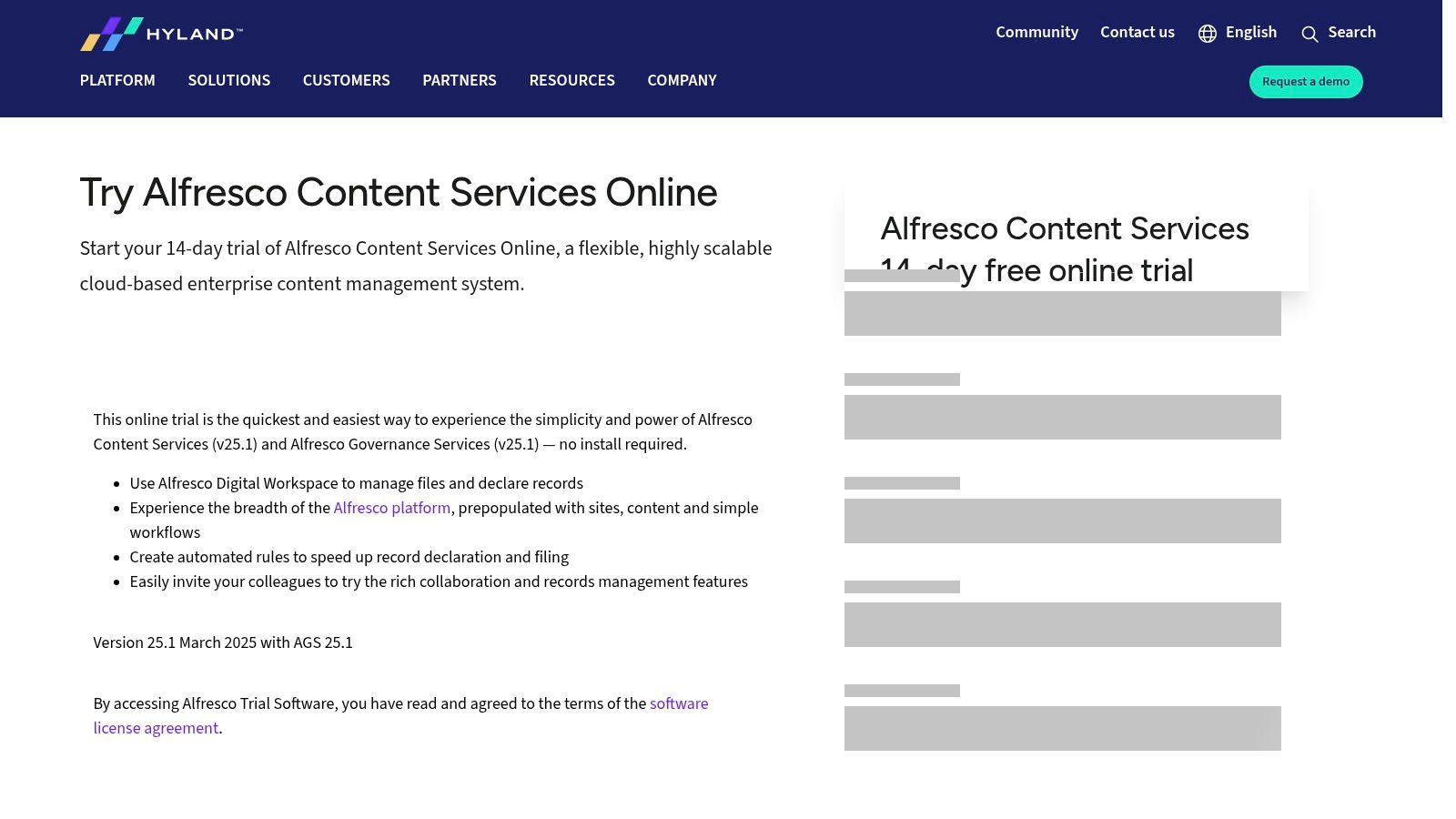
Alfresco solidifies its position as one of the best enterprise content management systems by catering directly to organizations that require deep customization and control over their content infrastructure. It provides robust records management capabilities and elastic scalability, ensuring it can handle the demands of large, complex organizations. The availability of a vibrant community edition alongside the enterprise version allows teams to evaluate and innovate freely before committing to a commercial relationship.
Key Considerations
Alfresco offers free online and download trials, providing a transparent path for evaluation. However, the full enterprise edition, which includes dedicated support and advanced add-ons, is priced via a custom quote. While the platform's open nature is a significant advantage, self-managed deployments demand a high level of DevOps maturity to handle the complexities of container orchestration and infrastructure management. Organizations without this in-house expertise may need to factor in additional costs for specialized implementation partners or opt for a PaaS (Platform-as-a-Service) deployment.
- Pros: Developer-friendly and easy to extend/integrate, clear product lifecycles, free trials available for evaluation.
- Cons: Self-managed deployments require DevOps maturity, enterprise support and add-ons are priced via quote.
- Website: https://www.hyland.com/en/resources/alfresco-ecm-online
6. IBM Cloud Pak for Business Automation (Content Services / FileNet)
For highly regulated industries requiring massive scale and robust governance, IBM's platform represents a powerful, integrated approach to content and process automation. Built on the legacy of FileNet, its Content Services component is designed to manage billions of documents while enforcing strict compliance and records management policies. The platform’s strength is its modularity, combining a high-scale content repository with workflow, AI-powered data capture, and decision management in a single, cohesive suite. This integration allows enterprises to build sophisticated, content-centric applications that automate entire business processes from start to finish.
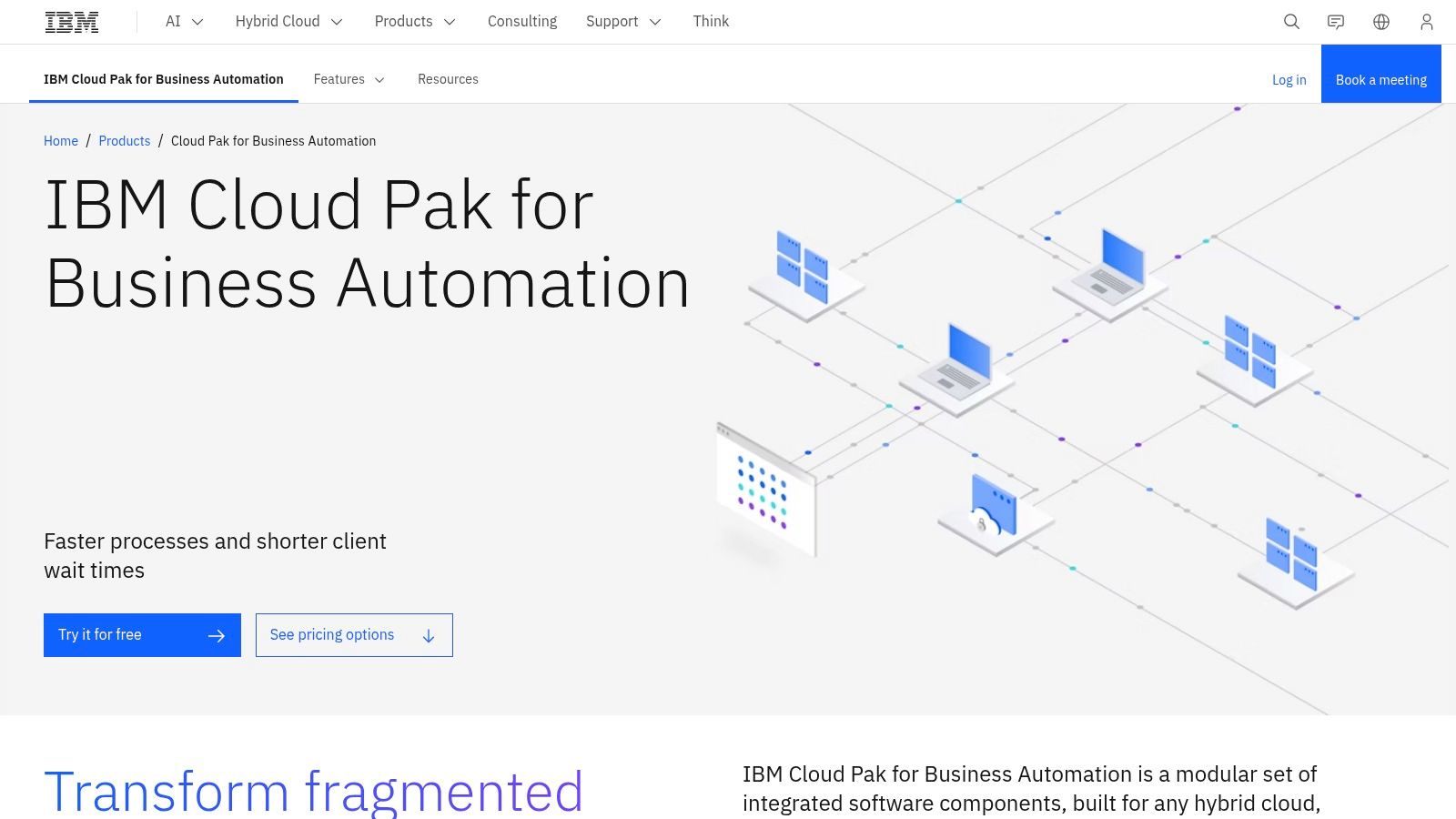
IBM Cloud Pak for Business Automation stands out as one of the best enterprise content management systems due to its hybrid-cloud flexibility. It can be deployed on any cloud via Red Hat OpenShift or consumed as a SaaS offering, giving organizations control over their infrastructure strategy. Its toolset includes low-code builders and robust APIs, enabling developers to create and extend content-aware applications efficiently.
Key Considerations
Licensing for the suite can be complex, with metrics based on virtual processor cores (vCPUs), decisions, and user roles, varying between self-managed and SaaS models. This requires careful planning to optimize costs. Furthermore, enterprise-wide deployments often demand specialized skills in the IBM ecosystem to configure the advanced governance, federation, and automation components effectively. For a deeper analysis of how it stacks up against other platforms, our content management system comparison offers additional insights.
- Pros: Proven at extreme scale, strong governance and records management, comprehensive automation tools under one license family.
- Cons: Complex licensing metrics can be difficult to forecast, enterprise rollouts often require specialized implementation skills.
- Website: https://www.ibm.com/products/cloud-pak-for-business-automation
7. Box (Enterprise, Enterprise Plus, Enterprise Advanced)
Box has evolved from a cloud storage solution into a comprehensive, cloud-native intelligent content management platform designed for the modern enterprise. It centralizes content, enabling secure collaboration, workflow automation, and governance from a single source. Its core strength is providing a highly secure and compliant environment for unstructured data, coupled with deep integrations into everyday business applications like Microsoft 365, Google Workspace, and Salesforce, making it a frictionless hub for enterprise content.

As one of the best enterprise content management systems, Box distinguishes itself with its focus on security and compliance, featuring advanced tools like Box Shield for threat detection and data loss prevention. The platform's recent infusion of Box AI brings intelligent capabilities like automated content summarization and Q&A directly within the secure content layer, enhancing knowledge discovery without compromising data privacy. This makes it ideal for regulated industries like financial services and healthcare.
Key Considerations
Box offers transparent per-user pricing across its Business and Enterprise tiers, which simplifies procurement and allows for predictable scaling. The higher-tier Enterprise plans unlock unlimited storage and advanced features like Box Governance for legal holds and Box Keysafe for customer-managed encryption. While the per-user cost can accumulate significantly for very large organizations, Enterprise License Agreements (ELAs) are available for more predictable multi-year spending. Organizations needing the most advanced security, governance, or AI features must opt for the higher-cost Enterprise Plus or the new Enterprise Advanced plans.
- Pros: Fast to purchase and deploy with clear per-user pricing tiers, Strong compliance options (HIPAA, FedRAMP on higher tiers), Enterprise License Agreement options for predictable multi-year spend.
- Cons: Advanced governance/security features may require higher-cost tiers, Per-user costs can accumulate at large seat counts.
- Website: https://www.box.com/pricing/
8. M-Files (with Hubshare)
M-Files introduces a paradigm shift in content management by organizing information based on what it is, not where it is stored. This metadata-driven approach eliminates chaotic folder structures, allowing users to find documents based on properties like client, project, or document type. Its deep integration with Microsoft 365 and Windows Explorer provides a familiar interface, while its powerful workflow automation engine streamlines business processes from contract approvals to quality control. The platform’s unique architecture ensures a single source of truth, connecting content across disparate systems without requiring data migration.
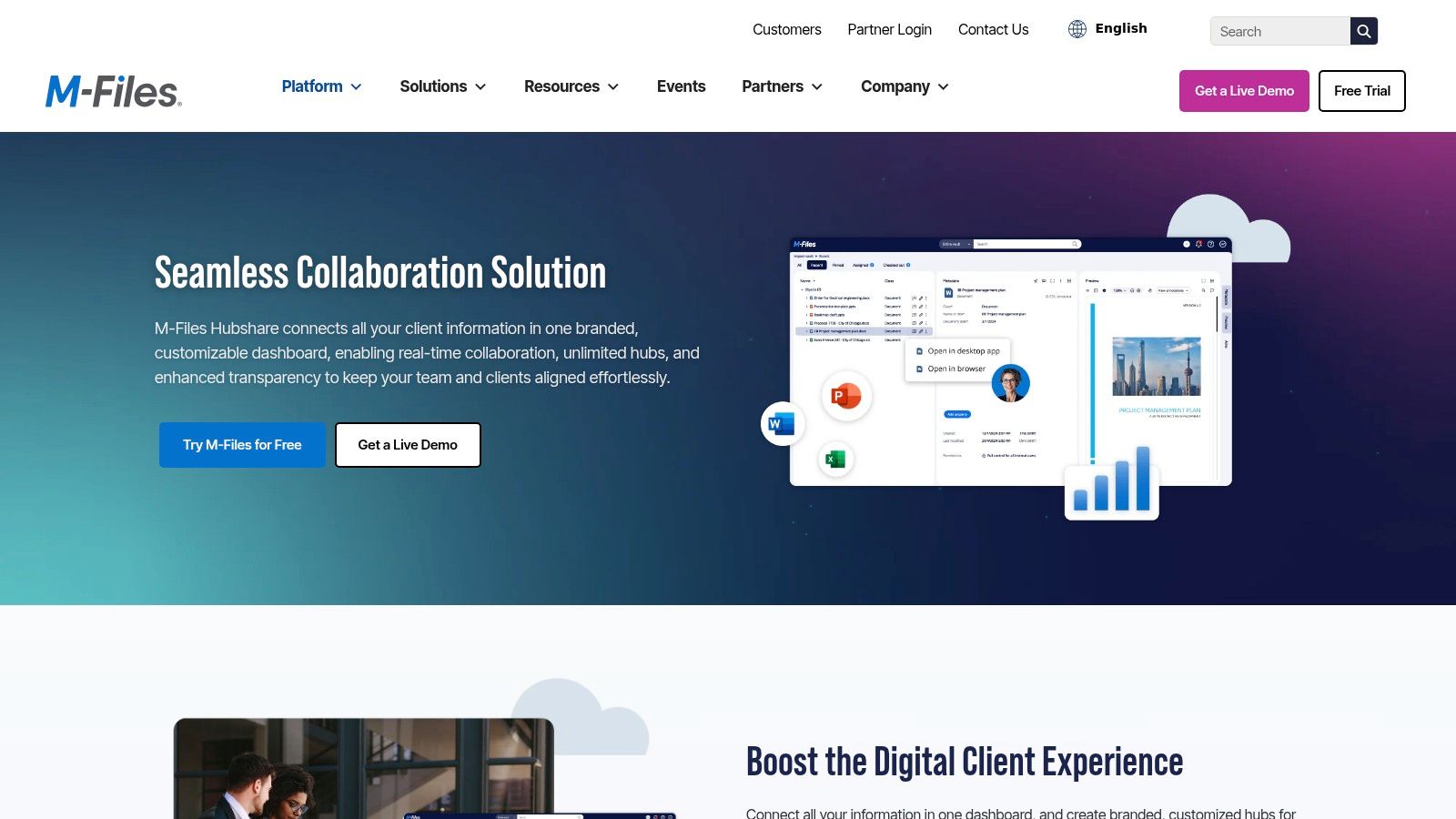
The addition of Hubshare transforms M-Files into one of the best enterprise content management systems for secure external collaboration. Hubshare allows organizations to create branded, secure client portals for sharing information, tracking project progress, and centralizing communication. This combination of powerful internal governance and elegant external sharing makes M-Files a versatile choice for industries like professional services, manufacturing, and life sciences, where both compliance and client experience are paramount. The platform offers flexible deployment, available on-premises, in the cloud, or through a hybrid model.
Key Considerations
M-Files does not provide public list pricing, as enterprise quotes are tailored based on the required edition, user count, and deployment model. While its metadata-first approach is incredibly powerful for reducing content chaos, it requires a well-planned information architecture and change management to implement successfully. Organizations may need to invest in professional services to configure advanced governance rules and workflows to fully leverage the platform's capabilities and ensure a smooth transition for users accustomed to traditional folder-based systems.
- Pros: Intuitive findability via metadata, excellent external collaboration with Hubshare, flexible deployment and strong Microsoft integration.
- Cons: Public pricing is limited and requires a custom quote, effective governance may require professional services for configuration.
- Website: https://www.m-files.com/solutions/hubshare/
9. Laserfiche (Cloud and self-hosted)
Laserfiche has carved a significant niche in the market by evolving from a document management tool into a comprehensive content services platform with powerful process automation. It is particularly well-suited for organizations in regulated industries and the public sector that need to digitize paper-based processes and automate complex workflows. The platform combines core document and records management with intuitive electronic forms, workflow automation, and robotic process automation (RPA) to create end-to-end business solutions. Its recent infusion of generative AI for smart metadata extraction and conversational search further modernizes its offering.
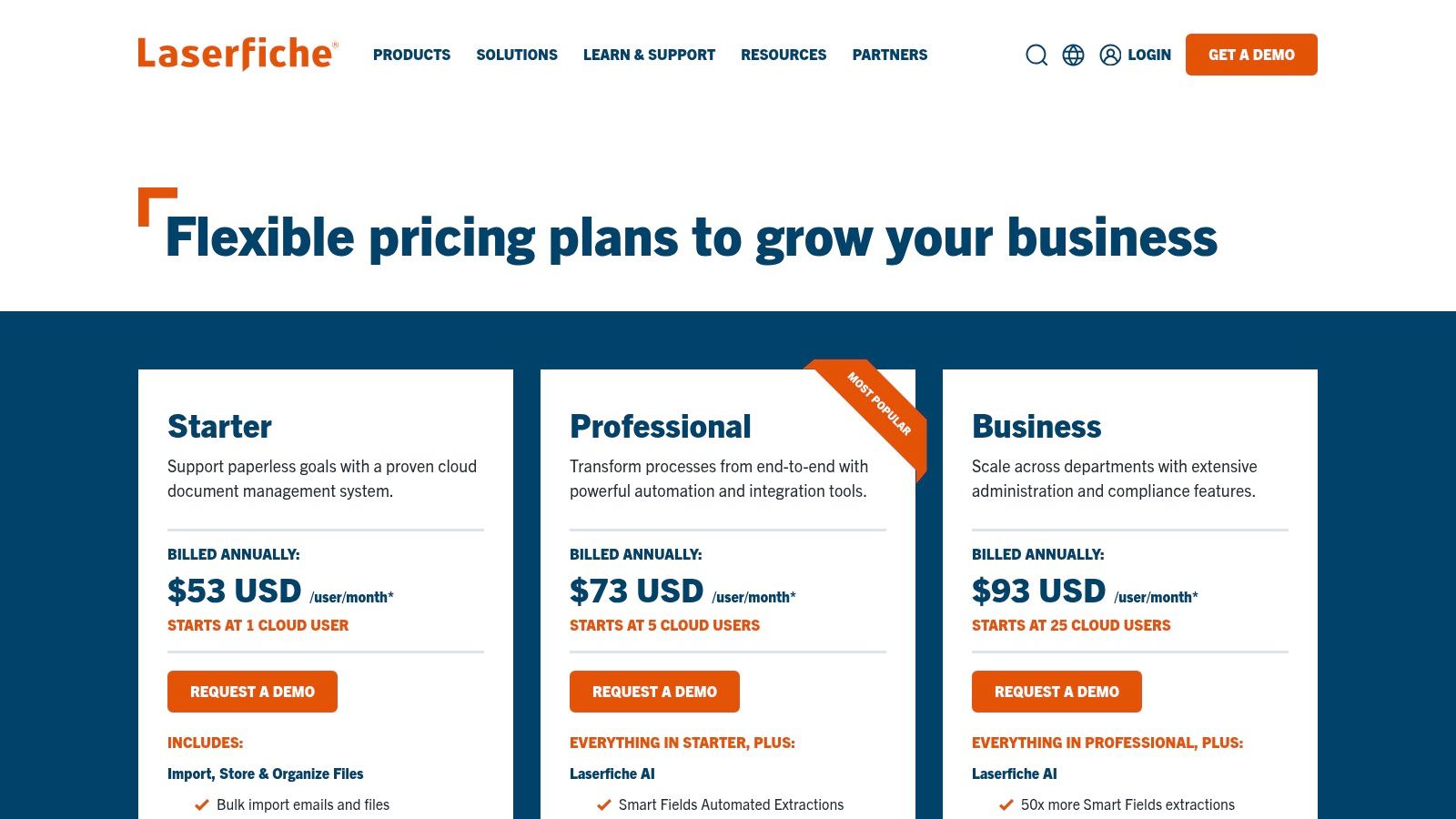
As one of the best enterprise content management systems, Laserfiche stands out for its strong focus on accelerating digital transformation with a quick time to value. The platform is supported by a robust marketplace of pre-built integrations for systems like Microsoft 365, Salesforce, and Workday, along with a global network of resellers who provide specialized implementation and support. This ecosystem makes it an accessible yet powerful choice for mid-market and enterprise clients looking to streamline operations.
Key Considerations
Laserfiche Cloud offers transparent, tiered per-user pricing, which simplifies initial investment calculations and makes it approachable for organizations starting their digital journey. Higher tiers unlock advanced capabilities, including options for FedRAMP or HIPAA compliance, which are critical for government and healthcare sectors. While the cloud version is agile, self-hosted deployments are still available but require a Windows-centric server environment. Organizations should note that some of the most advanced compliance and automation features are reserved for the premium subscription tiers, which can impact the total cost for those with extensive requirements.
- Pros: Clear entry pricing and quick time to value in the cloud, robust automation and integration ecosystem, strong public-sector traction and reseller support.
- Cons: Some advanced compliance/features available only in higher tiers, self-hosted deployments require Windows-centric components.
- Website: https://www.laserfiche.com/products/pricing/
10. DocuWare (a Ricoh company)
DocuWare offers a highly structured approach to enterprise content management, targeting small-to-mid-enterprise clients with a focus on digitizing document-heavy processes. Its strengths lie in intelligent document processing and workflow automation, making it ideal for departments like HR, accounting, and legal. The platform uses AI-assisted indexing to automatically capture and organize data from scanned documents and digital forms, drastically reducing manual entry and improving accuracy.
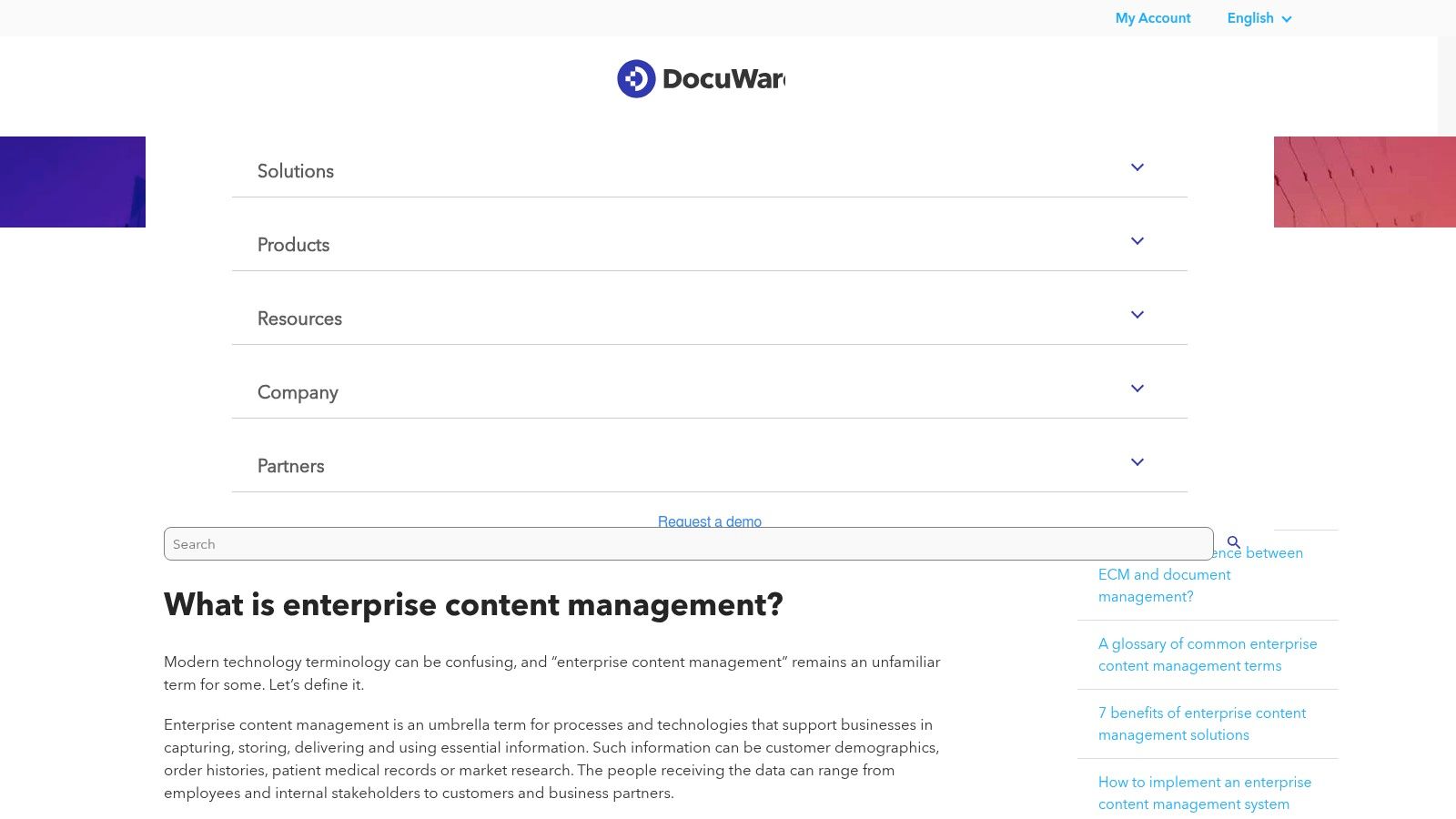
As one of the best enterprise content management systems for targeted departmental solutions, DocuWare provides both cloud and on-premises deployment options for maximum flexibility. Its pre-packaged cloud plans are designed for rapid deployment, helping teams achieve a strong and measurable return on investment quickly. The system integrates well with existing business applications, including Microsoft 365 add-ins and iPaaS connectors, ensuring it can become a central hub for business-critical documents and processes.
Key Considerations
DocuWare's cloud pricing is structured around user counts and storage tiers, with all core features included across plans, which simplifies purchasing. However, the company's website does not provide public pricing details; most engagements require a custom quote through their extensive partner network. This partner-led model provides localized expertise for implementation and support. While the web client is universally accessible, some advanced desktop client functionality may be limited to Windows users, a key point for organizations with diverse operating systems.
- Pros: Complete feature set included across cloud plans, quick deployments for strong ROI, broad partner ecosystem for implementation.
- Cons: Limited public pricing requires a formal quote, some desktop client features may be Windows-only.
- Website: https://start.docuware.com/enterprise-content-management
11. Oracle Content Management and WebCenter (OCI)
For enterprises deeply invested in the Oracle technology stack, Oracle Content Management (OCM) and the on-premise WebCenter suite represent a powerful, integrated solution. OCM, delivered via Oracle Cloud Infrastructure (OCI), provides modern headless and hybrid content services with a robust developer framework. It is designed to create, manage, and deliver assets and structured content to any channel or application, making it a strong contender among the best enterprise content management systems for Oracle-centric organizations. This close alignment with Oracle's Customer Experience (CX) and Commerce platforms creates a cohesive digital ecosystem.
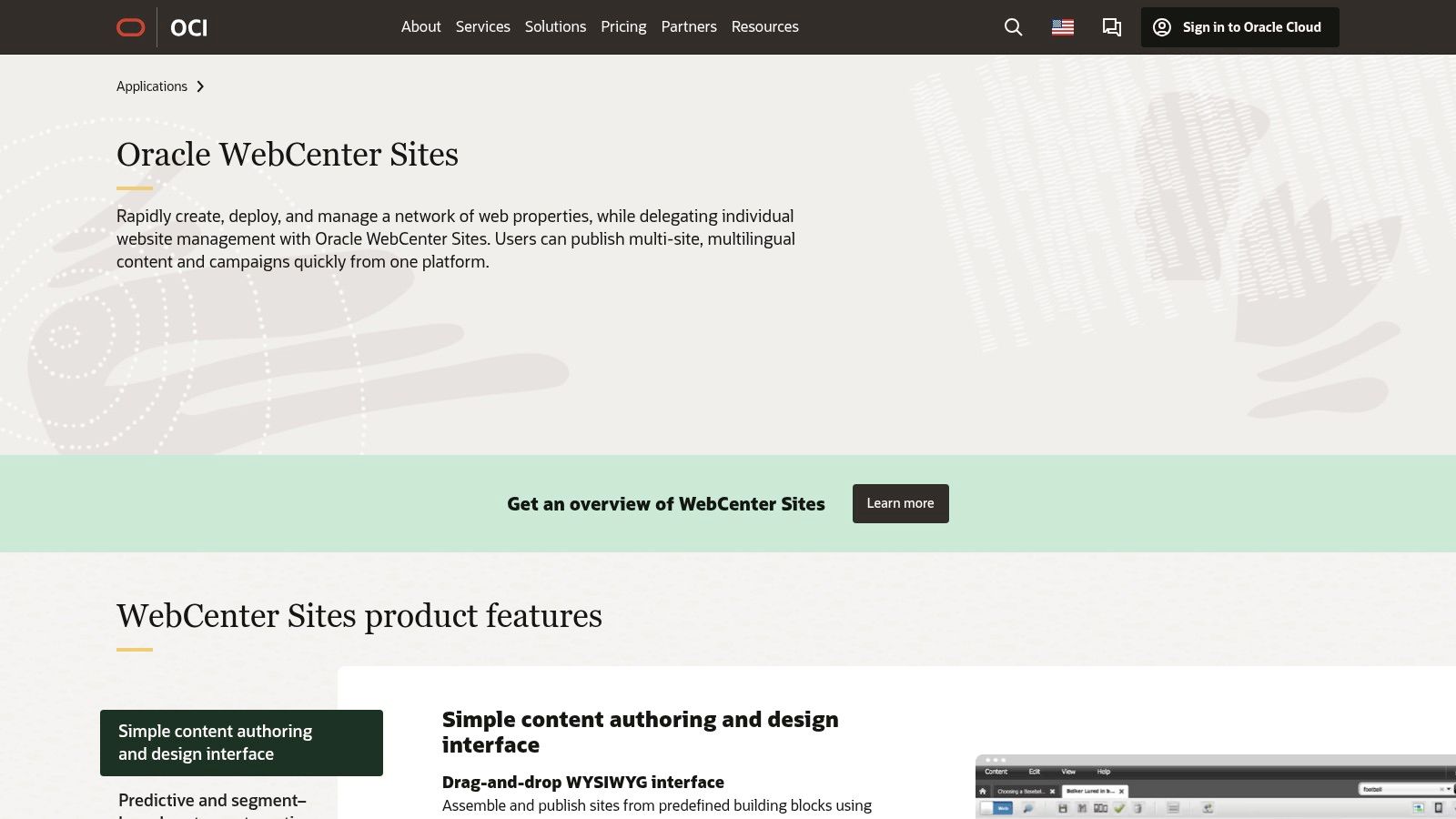
The platform stands out by offering both a mature, on-premise digital experience platform (WebCenter Sites) for complex multi-site and multilingual web management, alongside its cloud-native, API-first counterpart. This dual offering caters to organizations at different stages of their cloud migration journey. Its strength lies in its native integrations across Oracle applications and its deployment flexibility on OCI, which allows for consumption-based pricing via Universal Credits.
Key Considerations
Pricing is managed through OCI's Universal Credits model or traditional licensing, which can be advantageous for existing Oracle customers. However, navigating the product portfolio and licensing options, particularly with different editions and feature limitations in the Starter Edition, can be complex. While enterprise support is a clear benefit for those on OCI, understanding the specific capabilities included in each tier is crucial for accurate cost forecasting and to avoid unexpected limitations during implementation.
- Pros: Strong fit for Oracle application stacks and OCI adopters, mature web experience management and headless content capabilities, enterprise support bundled with OCI services.
- Cons: Product portfolio and licensing can be complex to navigate, some capabilities vary by edition and Starter Edition has feature limits.
- Website: https://www.oracle.com/content-management/webcenter-sites/
12. AWS Marketplace (ECM listings and procurement)
For organizations deeply invested in the Amazon Web Services cloud, AWS Marketplace serves as a powerful procurement and deployment hub rather than a standalone ECM. It streamlines the acquisition of leading enterprise content management systems like Hyland OnBase and OpenText by consolidating contracting and billing directly through an existing AWS account. This approach significantly accelerates vendor onboarding and aligns software purchasing with established cloud governance and financial operations. It allows enterprises to deploy solutions quickly into their AWS environment with clear infrastructure cost models.

AWS Marketplace stands out by offering a catalog that includes both turnkey SaaS and deployable AMI or hosted solutions, giving buyers flexibility. Its value is in simplifying the often-complex procurement cycle for enterprise software. The platform supports private offers, metered contracts, and bundled financing, allowing for commercial terms that fit diverse enterprise needs while ensuring new software aligns with internal AWS security and compliance baselines.
Key Considerations
Pricing models on the marketplace vary by vendor, with many offering transparent seat-based tiers. A key financial consideration is that the listed software cost is often separate from the underlying AWS infrastructure charges required to run the solution, which must be factored into the total cost of ownership. While the marketplace offers a vast selection, not every ECM vendor provides full public pricing or free trials, sometimes requiring direct engagement for a complete quote.
- Pros: Centralized billing with AWS reduces vendor onboarding effort, transparent pricing on many listings, option to align solutions with AWS security baselines.
- Cons: Not all vendors publish full public pricing or trials, additional AWS infrastructure charges may apply on top of software costs.
- Website: https://aws.amazon.com/marketplace/
Top 12 Enterprise Content Management Systems Comparison
Making the Right Choice: Partnering for Long-Term Success
Navigating the landscape of the best enterprise content management systems can be a formidable task. This guide has detailed the unique strengths of various platforms, from the collaborative power of Microsoft SharePoint within the M365 ecosystem to the specialized, secure content services offered by Hyland, OpenText, and IBM. Each system presents a compelling case, but the final decision hinges less on a simple feature-for-feature comparison and more on a deep alignment with your organization's long-term strategic vision.
The central takeaway is this: selecting an ECM is not merely a software procurement decision; it is the foundation of your future digital architecture. The right choice will empower every department, streamline complex workflows, secure critical information assets, and, most importantly, create seamless digital experiences for your customers and employees. It requires looking beyond the immediate needs of content storage and toward future goals of personalization, omnichannel delivery, and data-driven insights.
From Content Repository to Experience Engine
For organizations aiming to lead their markets, the conversation naturally shifts from traditional ECM to a more holistic Digital Experience Platform (DXP). This is where a solution like Sitecore truly distinguishes itself. While platforms like SharePoint excel at internal collaboration and document management, Sitecore is engineered from the ground up to unify content, commerce, and customer data into a single, powerful engine for personalized engagement.
Its composable DXP architecture allows enterprises to build a bespoke technology stack that evolves with business needs, integrating advanced tools like personalization, marketing automation, and customer data platforms (CDP). This strategic shift turns content from a static asset into a dynamic driver of business growth, making every digital interaction relevant and impactful. Choosing a platform of this caliber is a commitment to digital maturity and a proactive step toward owning the customer journey.
The Critical Role of Implementation and Partnership
The most powerful platform in the world will fail to deliver ROI without the right implementation strategy and expert partner. The initial setup, data migration, and system integration are just the beginning. True value is unlocked through continuous optimization, strategic governance, and expert guidance that aligns the technology with your evolving business objectives.
Consider these critical factors before finalizing your decision:
- Total Cost of Ownership (TCO): Look beyond licensing fees. Factor in implementation costs, required integrations, ongoing maintenance, necessary training for your teams, and the potential need for specialized development resources. A clear TCO picture prevents unexpected budgetary strain down the road.
- Scalability and Future-Proofing: Your chosen system must grow with you. Assess its ability to handle increasing content volume, user loads, and geographic expansion. For platforms like Sitecore, consider how its composable nature allows you to add or swap components like Sitecore Search or CDP as your strategic needs mature.
- Implementation Partner Expertise: This is arguably the most crucial factor. A partner with deep, certified expertise in your chosen platform, especially for complex systems like Sitecore or SharePoint, is non-negotiable. They act as your strategic guide, translating business needs into technical solutions and ensuring you leverage every feature to its fullest potential. Their experience mitigates risk, accelerates deployment, and maximizes your investment.
Ultimately, selecting one of the best enterprise content management systems is about forging a partnership. You are choosing a technology partner and, just as importantly, an implementation partner who will stand by you through the entire lifecycle of your digital transformation. The right combination will not only solve today's content challenges but will also build a resilient, agile, and intelligent foundation for whatever comes next.
Choosing the right platform is only half the battle; unlocking its full potential requires a partner with proven expertise. As certified Sitecore specialists with over a decade of experience, Kogifi provides the strategic guidance, technical implementation, and ongoing support needed to transform your ECM investment into a competitive advantage. Connect with our experts at Kogifi to start building a digital foundation that drives real business results.

















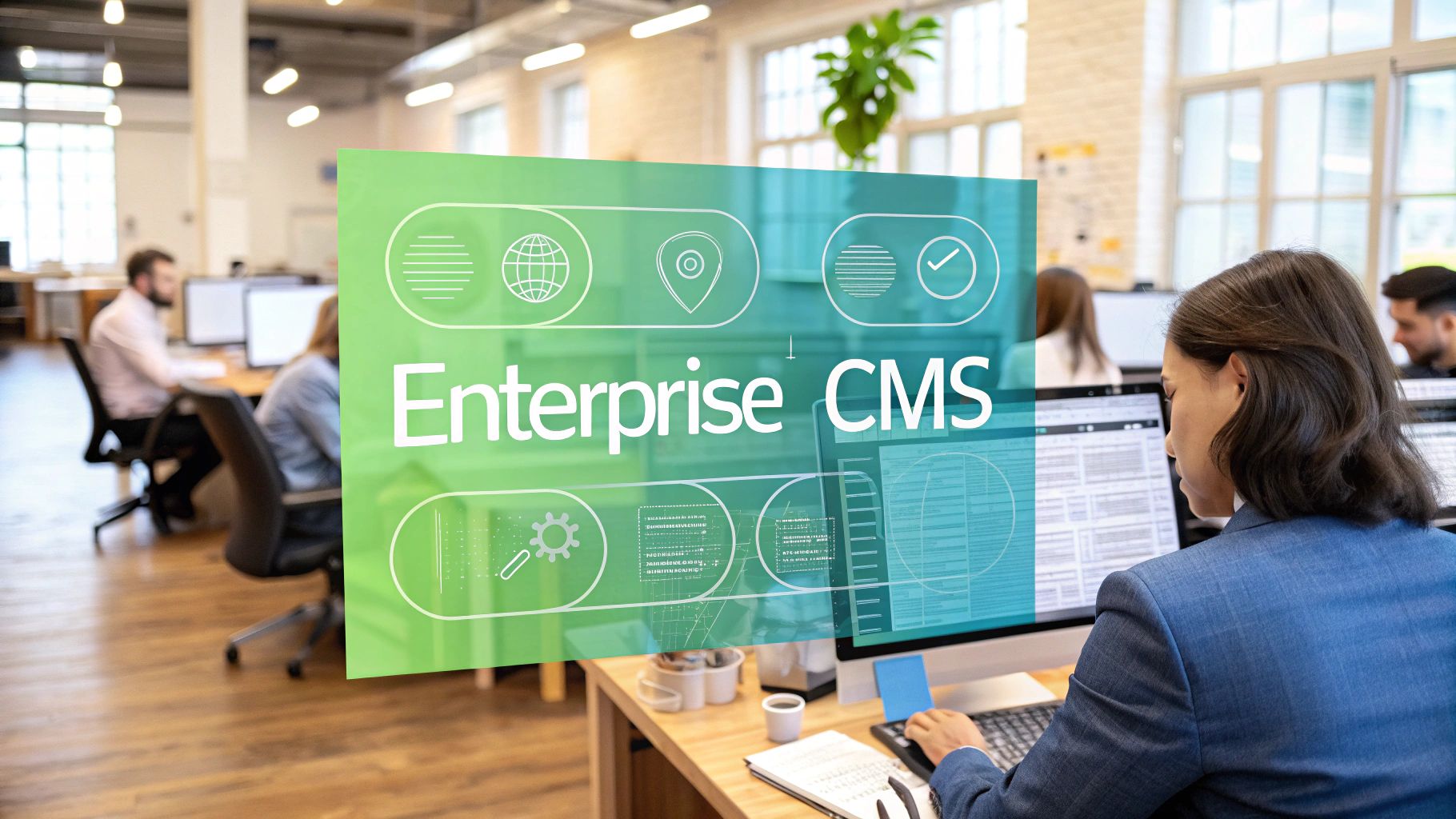




.jpeg)
